|
VERY RARE HISTORICAL GROUPING FROM THE MODOC WARS
OF 1873 INCLUDING A MODEL 1868 .50/70 SPRINGFIELD RIFLE
SEIZED FROM THE MODOCS BY LT. FRAZIER BOUTELLE AND
PERSONAL ITEMS RELATED TO TWO OFFICERS KILLED BY THE
MODOCS ON APRIL 11, 1873 - A CABINET CARD OF GEN. EDWARD
CANBY, AND AN 1872 US ARMY SWORD EXERCISE MANUAL OWNED
BY LT. WILLIAM SHERWOOD: These three artifacts
not only relate to The Modoc War of 1872-1873 which
occurred in California and Oregon, but they are directly
associated with specific incidents during the Lost River
Battle in November-December of 1872 and the
assassinations of General Canby and Lt. Sherwood on
April 11, 1873. This is an important historic grouping
from the early years of the Indian Wars.
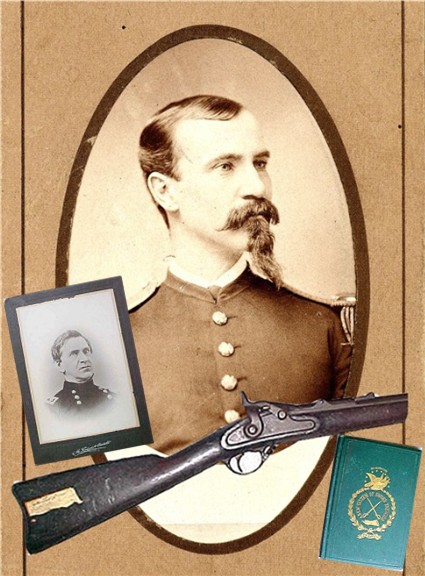
THE Springfield
RIFLE: The provenance of this Model
1868 Springfield Rifle traces back to one of the best
known Indian Wars historians of our time – Ed Green,
curator of the US Army Museum at the Presidio of
Monterey. Ed was known for his ability to ferret out
special artifacts of historic significance, and this
rifle is no exception. With the rifle, Ed obtained the
cabinet card of General Edward Canby and a Modoc quiver,
arrows and bow. Unfortunately the bow and quiver were
separated at some point, but the rifle and cabinet card
were maintained as a set and that is how I acquired
them.
 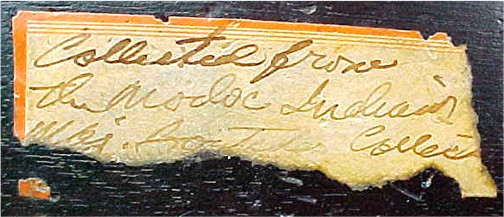
FOR MORE
DETAILED PHOTOGRAPHS OF THE RIFLE, SEE BELOW
Of particular importance, there is a very old paper tag
pasted to the right flat of the butt stock bearing the
faded handwritten inscription in ink, “Collected from
the Modoc Indians/ Major Boutelle Collect-“. While some
of the tag has been worn away with the passage of time,
by enhancing the remaining text with digital
photography, the portion of the label that is present is
fully legible and distinct. Researching the connection
of Major Boutelle to this rifle revealed a long and
fascinating military career.
Born in Troy, New York in 1840, Frazier Augustus
Boutelle enlisted as a sergeant in the 5TH
New York Cavalry in 1861, was commissioned in 1862 and
finished the Civil War as a Captain. Apparently
military life agreed with him, as he enlisted as a
private in the 1ST US Cavalry in 1866. By
1867 he had been promoted to Sergeant Major of the
regiment and in 1869 he was commissioned as a second
lieutenant, again joining the officer corps.
In 1872 the 1ST Cavalry was engaged with the
Modocs in northern California. In what became
recognized as the opening incident of the Modoc War,
Lt. Boutelle was ordered to locate, arrest, and return
Captain Jack, chief of the Modocs, and his leaders to
the Klamath Reservation. Boutelle and Scarface Charley,
one of Captain Jack’s principle lieutenants, are
credited with firing the first hostile shots of the
campaign, trading gun fire at close quarters which
resulted in clipping each others’ clothing without
inflicting any injuries. Boutelle continued to serve on
this campaign through its conclusion and he had ample
opportunity to acquire this rifle from the Modocs,
leaving little room for doubt that the attribution to
the Modocs on the paper tag is genuine. As the tag
refers to “Major” Boutelle, the tag must have been
affixed to the rifle later in his career in an effort to
ensure the story of its recovery was not lost with the
passage of time.
One of the early cartridge conversions executed by the
Springfield Armory, the Model 1868 Springfield Rifle
acquitted itself very well on the frontier, not only in
the hands of the soldiers, but in use by the
frontiersmen and Indians as well. This rifle shows all
the indications of being one of those that passed from
the army into the hands of an Indian, and it is a truly
unique, and historically important, survivor of the
American West.
Showing all of the wear expected on an Indian used gun,
the metal has a deep, even brown patina without being
heavily pitted. All of the stamps in the lock plate,
breech block and barrel are visible, to include the
matching serial numbers on the full length barrel and
the receiver. The lock-trigger mechanism functions
properly and the breech block opens and locks in place
as it should. All of the components are original to the
period of use, including the cleaning rod. A barrel
band from another rifle that was pressed into service to
replace the upper band and the rear sight leaf was cut
away, leaving a short stub – both characteristic of the
sort of repairs and replacement parts noted on Indian
used guns.
The stock exhibits heavy use, with the sort of dents,
scratches and handling wear that is expected. While the
stock is intact and strong, there is a pair of cracks
beginning at the e front trigger guard tang and rising
up to the front end of the lock plate on one side and to
the front lock screw on the other, however there is no
movement to the wood or metal in the area of the
cracks. There are two sets of old unit issue inventory
stamps – one at the top of the wrist and one immediately
in front of the butt plate tang – which testify to the
rifle’s initial use by the military. There are also
some initials carved in the left flat of the butt
plate. Of particular interest in light of the rifle’s
association with the Modocs, there is a single line of
brass, square shanked flat head nails decorating the top
of the wrist and comb. Three of the nail heads were
broken off or worn away, but all of the remaining heads
bear the stamped legend, “J1”. Identification nails
such as these were used to mark timber, lumber, and
other materials and were available during the period of
use of this rifle and would have been available to the
Indians through trade or in the form of goods captured
during raids on the frontier communities and wagon
parties.
THE CABINET CARD:
General Edward R.S. Canby had a long and varied career,
beginning with his graduation from West Point in the
Class of 1839, service in the Seminole, Mexican and Utah
Wars, and notable service during the Civil War resulted
in his promotion to the rank of major general. While
his service included many notable assignments and
distinguished accomplishments, unfortunately he is best
known as the only general officer of the US Army who was
killed in action during the Indian Wars. At the time of
his death, General Canby was leading a peace commission
which was attempting to negotiate the return of the
Modocs to the Klamath Reservation.
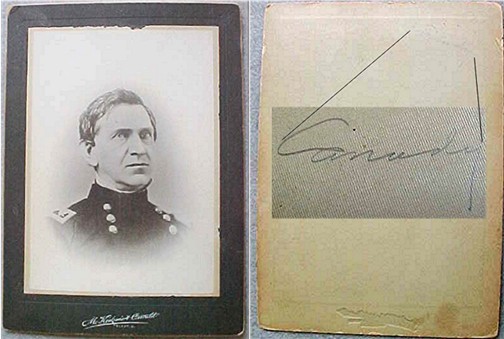
On April 11, 1873, Canby and the peace commissioners
were scheduled to meet with the leadership of the Modocs
including Captain Jack. Frustrated that their pleas for
a reservation of their own had gone unheeded, the Modocs
had planned in advance to murder Canby and the
commissioners. Captain Jack was opposed to the attack
and intended to make their demands heard one more time.
When Canby – who was unarmed – replied that he did not
have the authority to make such a promise, Captain Jack
attacked the general, shooting him twice in the head and
slitting his throat. The other Modocs present attacked
the other members of the party killing Rev. Eleazar
Thomas and wounding several others.
Eventually, Captain Jack, Boston Charley, Schonchin John
and Black Jim were tried for murder, convicted, and
executed on October 3, 1873. The surviving Modoc were
sent to reservations.
Canby's body was returned to Indiana and interned
at Crown Hill Cemetery, Indianapolis, Indiana on May 23,
1873 with at least four generals in attendance: William
Tecumseh Sherman, Philip Sheridan, Lew Wallace,
and Irvin McDowell.
Measuring 7 by 5”, this image was taken after Canby's
promotion to general officer in 1862, and a handwritten
inscription “CANBY” is on the reverse. The image is
clear and bright with no stains or other imperfections.
The card is full form with nice edges. The only sign of
wear is to the edges of the thin beige paper stock to
which the image itself is attached. The edges of the
image are untouched, but there is minor wear to the
backing sheet – hardly noticeable, but mentioned here in
the interest of a complete description.
THE MANUAL:
Another causality of the Modoc War, First Lieutenant
William L. Sherwood, was on duty at another outpost
surrounding the hostiles’ Stronghold when he was
mortally wounded only ten minutes before Gen. Canby was
killed.
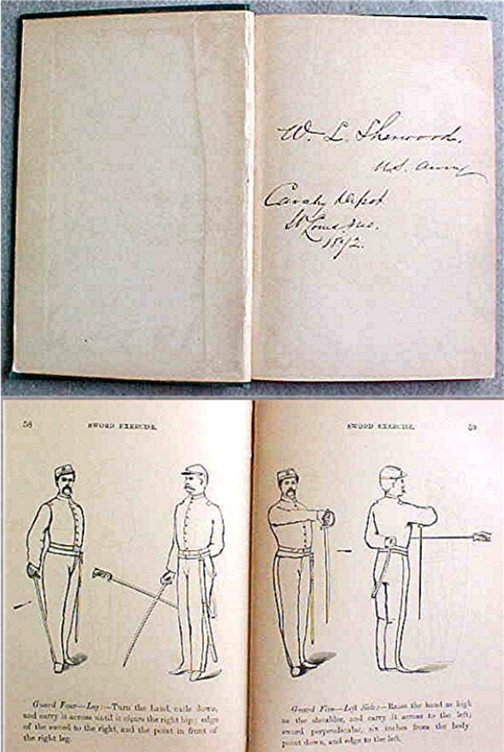
Sherwood had been commissioned in 1867 as a second
lieutenant in the 21ST US Infantry Regiment,
and having served with the regiment in the Arizona
Territory, transferred with the unit to northern
California to engage the Modocs. Known by his fellow
company grade officers and the senior officers of the
regiment as an energetic, conscientious officer,
Sherwood was on duty as the officer of the day when his
post was approached by a party of Modocs who indicated a
desire to parley. Sherwood and another lieutenant went
forward of their lines to meet with the Modocs and once
they were beyond the protection of the pickets, the
Modocs opened fire, striking Sherwood in the arm and
leg. Sherwood was recovered and carried back to camp
where he died of his wounds on April 14, 1873.
In May
of 1873 his remains were returned to Buffalo, New York
and interred at the Forest Lawn Cemetery.
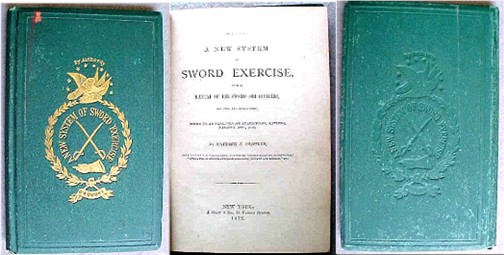
Acquired by Lt. Sherwood on his way west, this US Army
manual, A New System of Sword Exercises bears a
handwritten inscription in ink on the front flyleaf, “W.
L. Sherwood. U.S. Army; Cavalry Depot, St. Louis, Mo.
1872”. Printed in 1872, the manual consists of 120
pages and is extensively appointed with numerous
diagrams illustrating the proper handling of the sword
and sabre. Having survived the years in excellent
condition, the manual shows minimal wear. The binding
is intact and all of the pages are securely attached.
The front cover retains its gold leaf title and the
green cloth cover boards are in very nice condition with
no significant wear and only one small spot at the top
edge of the front cover.
The Model 1868 Springfield Rifle, the cabinet card and
the manual are accompanied by a binder of research
material on all three men – Boutelle, Canby and
Sherwood. The research includes biographical
information, photographs of their burial sites, and in
the case of Boutelle – as a result of his bequest of his
personal papers to the University of Oregon, I have
secured a considerable collection of photocopies of his
personal papers relating to his military career,
certificates of his commissioning and promotions,
personal letters of recommendation, newspaper articles
highlighting his career, and an considerable collection
of personal photographs documenting his service on the
frontier obtained from the U of O archive and contained
on an electronic disc.
The offering represents a very rare and unique grouping
of artifacts related to one of the earliest of the
Western Indian Wars. Due to the relatively brief
duration of the Modoc War, artifacts directly related to
that conflict seldom, if ever, appear on the market.
These three pieces not only belong together, but offered
as a grouping, they provide a ready made display of
significant historic importance and they deserve a place
of prominence in a collection where they will be
appreciated.
SOLD
|

